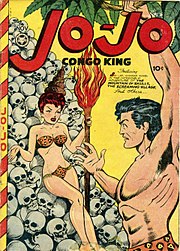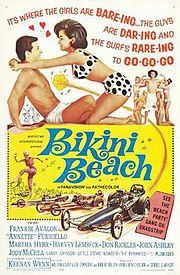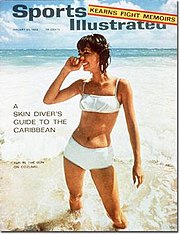 Bikini in comic books: From Jo-Jo, Congo King published by Fox Feature Syndicate
Bikini in comic books: From Jo-Jo, Congo King published by Fox Feature Syndicate
Bikinis appear in competitions, films, magazines, music, literature, magazines and even video games. Despite the easy availability of more revealing glamour imagery, bikini modeling remains popular and can still stir controversy.
The Bikini Planet is a science fiction comedy written by David S. Garnett and released exclusively in the UK as a paperback. It was written as a sub-sequel to an earlier story by Garnett in 1994, entitled Stargonauts, and features some of its settings and characters.
Bikini News is a series of satirical news videos featuring two comediennes performing in bikinis in a comedic style similar to The Daily Show and Saturday Night Live available in podcast and vodcast form, as well as in mov and wmv file formats. As of October 2007, over 90 episodes and 80 bloopers/sketches have been created. NCIS, an American police procedural television series revolving around a fictional team of special agents, had an episode on Bikini Wax (18th epidosde, 2nd season). Bikini Bottom is a city that appears in the Nickelodeon animated television series, SpongeBob SquarePants. Located at the bottom of the Pacific Ocean, it is where the series' main characters live, and where most of the episodes take place.
The Bikini Karate Babes is a digitized 2D fighting game developed by Creative Edge Studios. It features an all-female cast of 19 fighters, all clad in bikinis and played by real actresses.
The Swedish Bikini Team was a group of American female models who appeared in an advertising campaign for Old Milwaukee beer. These commercials ran for several months in 1991 in the United States, playing with American stereotype of blonde and big breastsed Scandinavian women. Feminist activists found the ads misogynistic. Though the campaign generated widespread interest, the advertisements were dropped after protests by the National Organization for Women and female employees of the Pabst Brewing Company.
Bikini contest
-----------------------------------------------------------------------------------------
 A bikini contest is a beauty contest where women compete against each other in bikinis. Bikini contests can take place in bars, nightclubs, strip clubs at beaches, and beauty pageants. Related companies regularly sponsor such contests to discover and attract new talents to promote their products. Bikini contests can also take place over the Internet by women submitting pictures of themselves in bikinis.
A bikini contest is a beauty contest where women compete against each other in bikinis. Bikini contests can take place in bars, nightclubs, strip clubs at beaches, and beauty pageants. Related companies regularly sponsor such contests to discover and attract new talents to promote their products. Bikini contests can also take place over the Internet by women submitting pictures of themselves in bikinis.
Contestants often wear sashes indicating where they are from in bikini contests, in similarity to the tradition in other beauty pageants. It is becoming more and more common for women to wear bikinis as part of the swimsuit competitions at major pageants. Participants in the Miss Teen USA pageant are now required to wear bikinis.
Movies
-----------------------------------------------------------------------------------------

Poster for Bikini Beach, one of the early Beach Party films made in 1964
Beach Party films were an American 1960s genre of feature films which often starred Annette Funicello and Frankie Avalon. They were originally intended as a low-budget imitation of both the Elvis Presley musical and the Doris Day sex comedy, aimed at the teen market, but they ended up taking on a life of their own. The "classic" series was produced by American International Pictures, and imitated in turn by numerous other studios. Beach Party (1963), Muscle Beach Party (1963), Bikini Beach (1964), Pajama Party (1964), Beach Blanket Bingo (1965), How to Stuff a Wild Bikini (1965), The Ghost in the Invisible Bikini (1966) are titles that were made as part of the classic beach party genre. The final entry in the original series was The Ghost in the Invisible Bikini, released in 1966. The end credits for another AIP Avalon comedy, Dr. Goldfoot and the Bikini Machine (1965) reveal that the original title planned for this film was The Girl in the Glass Bikini, and that Funicello and Avalon were slated to appear. However, Funicello and Avalon both passed, and the leads in The Ghost in the Invisible Bikini were played by Tommy Kirk and Deborah Walley.
Avalon and Funicello starred in Paramount Pictures Back to the Beach in 1987, playing off their original roles and subsequent careers. The 1965 movie Ski Party (with Dwayne Hickman, Yvonne Craig, Lesley Gore and James Brown) is also notable for employing many of the same actors and schticks, only transplanted to a ski resort in the Sawtooth National Forest. The 1996 movie That Thing You Do! touches briefly on the phenomenon, with the Wonders making an appearance in a fictional beach party movie, Weekend at Party Pier. A 2001 episode of Sabrina, the Teenage Witch ("Beach Blanket Bizarro") also paid homage to the series, with Avalon appearing as himself.
Bikini Cavegirl, The Bikini Carwash Company, How to Stuff a Wild Bikini, The Ghost in the Invisible Bikini, and It's a Bikini World are some of the many films that have plotlines revolving around the bikini.
Depictions of metal bikinis in art
-----------------------------------------------------------------------------------------
 Carrie Fisher as Princess Leia wearing the metal bikini in the Return of the Jedi (Star Wars: Episode VI) was voted one of the most memorable swimsuit moments of cinema history.
Carrie Fisher as Princess Leia wearing the metal bikini in the Return of the Jedi (Star Wars: Episode VI) was voted one of the most memorable swimsuit moments of cinema history.
A variant of the bikini popular in fantasy literature, originating from the cover-art of Earle K. Bergey (a direct inspiration for Princess Leias outfit), is a bikini that is made up of metal to serve as (admittedly rather impractical) armor, sometimes referred to as a "chain mail bikini" or "brass bikini". The character Red Sonja is a famous example of such; the game Poxnora is another example, in which all the women wear bikini-like clothing. A term for such usage, where sex appeal is more important than actual practicality, is babes-at-arms (parodying "men-at-arms" for fully armoured soldiers). In science fiction, Star Wars Episode VI: Return of the Jedi features the notable "Princess Leia's metal bikini". It is worn by the character Princess Leia when she is held captive by Jabba the Hutt at the film's beginning. This particular "bikini" has since been elevated to pop culture icon status, spawning various spoofs and parodies (notably the episode of Friends, "The One with the Princess Leia Fantasy") and even a dedicated fansite — Leia's Metal Bikini.
Music
-----------------------------------------------------------------------------------------
Itsy Bitsy Teenie Weenie Yellow Polka Dot Bikini, a singles written by Paul Vance and Lee Pockriss, has become a part of the history of the bikini. Released on August 8, 1960, it was also the first single sung by Brian Hyland to enter Billboard Hot 100. The song features in 1961 Billy Wilder film comedy One, Two, Three, as well as films like Sister Act 2 and Revenge of the Nerds II. It also features in commercials for Yoplait light yogurt, YWCA, and TV Easy magazine.
Do The Bikini Dance, a single by Dee Dee Ramone, was released on the day Ramones were inducted into the Rock And Roll Hall Of Fame in 2002. In the Gang of Four song "I Found That Essence Rare", the Bikini is suggested to be "...dressed for the H-Bomb...". In 1997 the French-German Electronic band Stereo Total released an album named Monokini. Hungarian rock band Bikini, Riot Grrrl movement induced punk rock band Bikini Kill and Los Angeles, California based electro-pop duo Cherry Bikini had names inspired by the bikini.
Magazines
-----------------------------------------------------------------------------------------
 The Sports Illustrated Swimsuit Issue is published annually by Sports Illustrated. It features fashion models wearing swimwear in exotic locales. Inclusion is considered a stick by which supermodels are measured. In addition, the issue is a media nexus that in 2005 carried $35 million in advertising. New issues come out around the middle of February or later. First published in 1964, it is credited with making the bikini a legitimate piece of apparel. The issue that got the most letters was the 1978 issue.The best selling issue was the 25th Anniversary Issue with Kathy Ireland on the cover in 1989.
The Sports Illustrated Swimsuit Issue is published annually by Sports Illustrated. It features fashion models wearing swimwear in exotic locales. Inclusion is considered a stick by which supermodels are measured. In addition, the issue is a media nexus that in 2005 carried $35 million in advertising. New issues come out around the middle of February or later. First published in 1964, it is credited with making the bikini a legitimate piece of apparel. The issue that got the most letters was the 1978 issue.The best selling issue was the 25th Anniversary Issue with Kathy Ireland on the cover in 1989.
Urbe Bikini (UB) is a Venezuelan, Maxim-styled monthly created by Urbe's editor-in-chief & creative director, Gabriel Torrelles and publisher, Carlos Lizarralde, who sold the company to the country's largest publisher, Cadena Capriles. It is the largest circulation glossy in the country and a cultural and circulation phenomenon in itself for more than 10 years.











0 comments:
Post a Comment